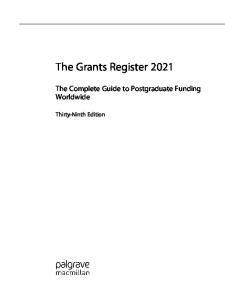The National Institute for Medical Research, Mill Hill
- PDF / 775,042 Bytes
- 8 Pages / 562 x 774 pts Page_size
- 54 Downloads / 298 Views
Arch Virol 140 (1995)
=~ Virology Division News ¥ JL../ . & . ,
Famous Institutions
ViroLogy
T h e N a t i o n a l Institute for M e d i c a l Research, M i l l H i l l J. s. Porterfield Goodleigh, Bamstaple, U.K.
Introduction Virology is a relatively new discipline having its roots in the study of infectious diseases of man, animals and plants [1]. The origins of virology at Mill Hill can be traced back to the National Insurance Act of 1911, so this brief history will start from that milestone and follow a roughly chronological course. My credentials for this task are that from 1949 to 1977 I worked for the Medical Research Council, first at Harvard Hospital (from Hampstead) and later at Mill Hill. This necessarily condensed personal account omits reference to many former colleagues who contributed to this unfolding virological scene, and to these I apologize. A more detailed history of events up to 1975 is given elsewhere [2], and a separate article in this series is devoted to interferon studies at Mill Hill [3].
Early years at Hampstead and the Mill Hill Farm Laboratory The 1911 Act provided that one penny per insured person should be set aside for medical research. In 1913 a Medical Research Committee was set up to define research objectives and to determine how the money so raised should be allocated. The Committee gave high priority to the creation of 'a central institute' in London and began the process of choosing senior staff and finding a suitable site. The distinguished bacteriologist Sir Almroth Wright was felt to be the only person of sufficient eminence to head the projected institute, and he was invited to be overall Director and head of the Bacteriology Department, assisted by Captain S. R. Douglas, formerly of the Indian Medical Service. Dr. H. H. (later Sir Henry) Dale was invited to head the Department of Biochemistry and Pharmacology, and Dr. L. (later Sir Leonard) Hill to head the Department of Applied Physiology. In March 1914 the former Mount Vernon Hospital in Hampstead was purchased, but the outbreak of World War I set back plans for its conversion into a research institute, and it became first the Hampstead Military Hospital and later the Central Hospital for Flying Officers. During the War research under Committee auspices was carried out in separate centres; Wright's group, strengthened by Dr. L. Colebrook and Dr. (later Sir) Alexander Fleming worked on war wounds and dysentery at the Inoculation Department at St. Mary's Hospital and at a Military Hospital in Boulogne; staff members in the other two departments carried out research at the London Hospital (Physiology) and at the Lister Institute (Biochemistry and Pharmacology).
1330
Virology Division News
In March 1920 the Medical Research Committee was reconstituted under Royal Charter as the Medical Research Council (MRC), and in April 1920 the refurbished Mount Vernon building opened as the National Institute for Medical Research (NIMR), bringing together for the first time the three departments of experimental research, but
Data Loading...











